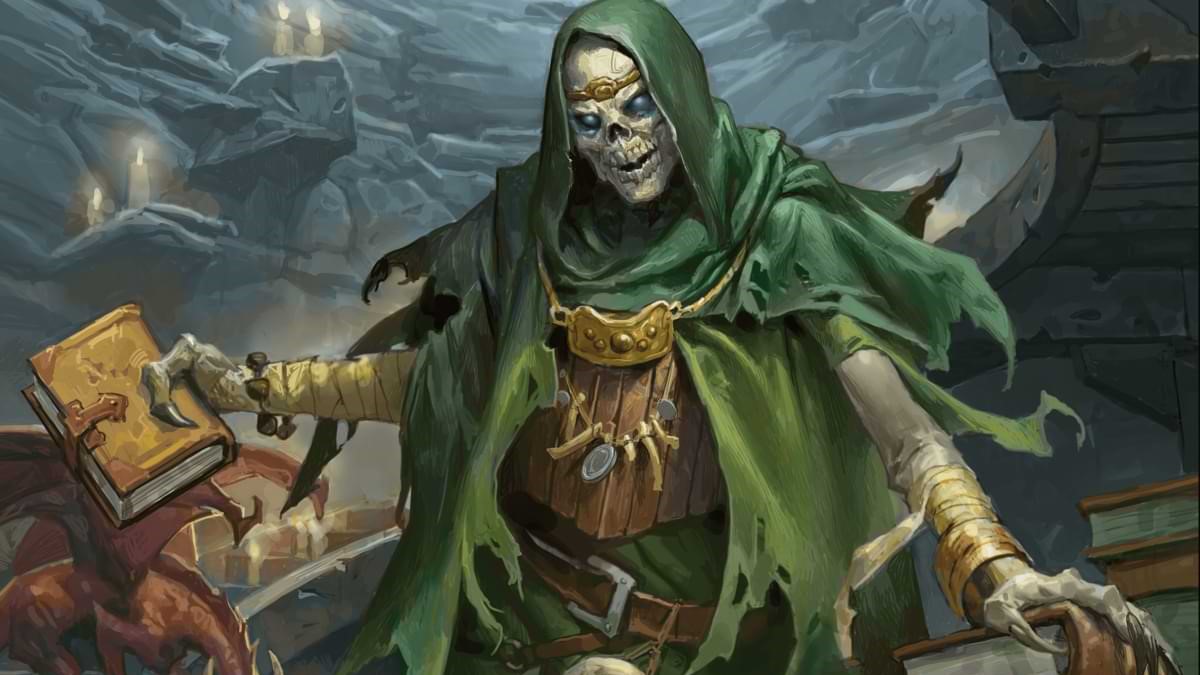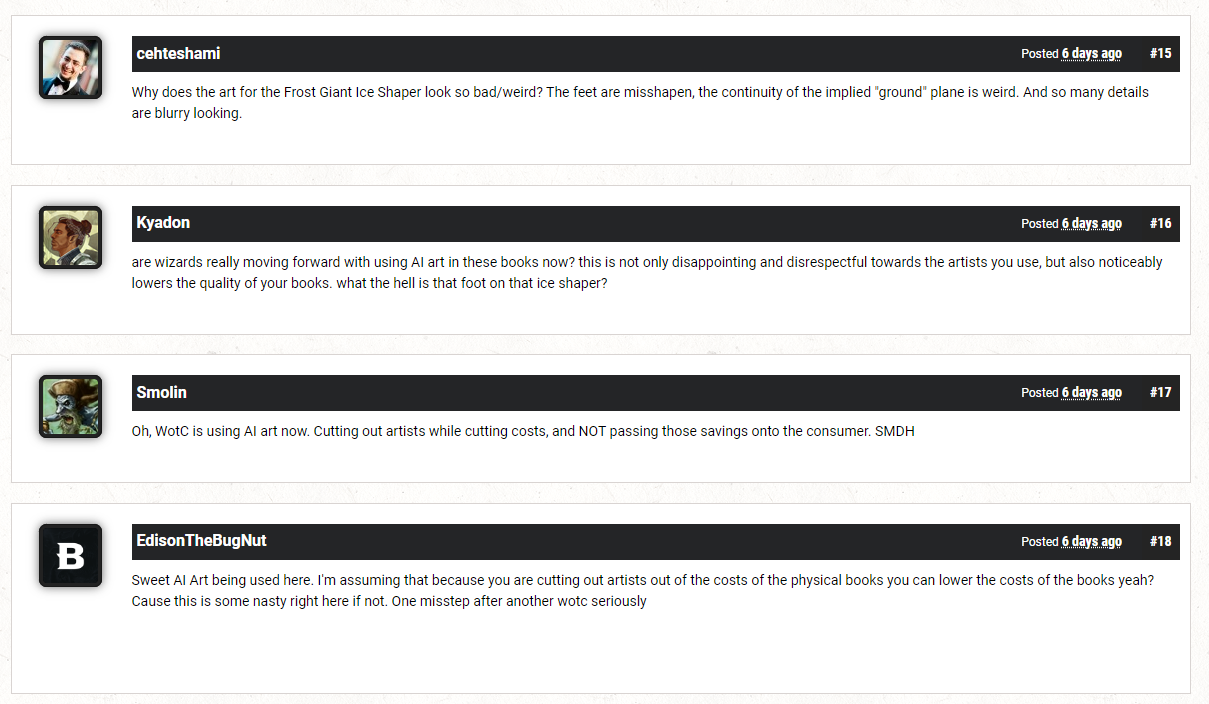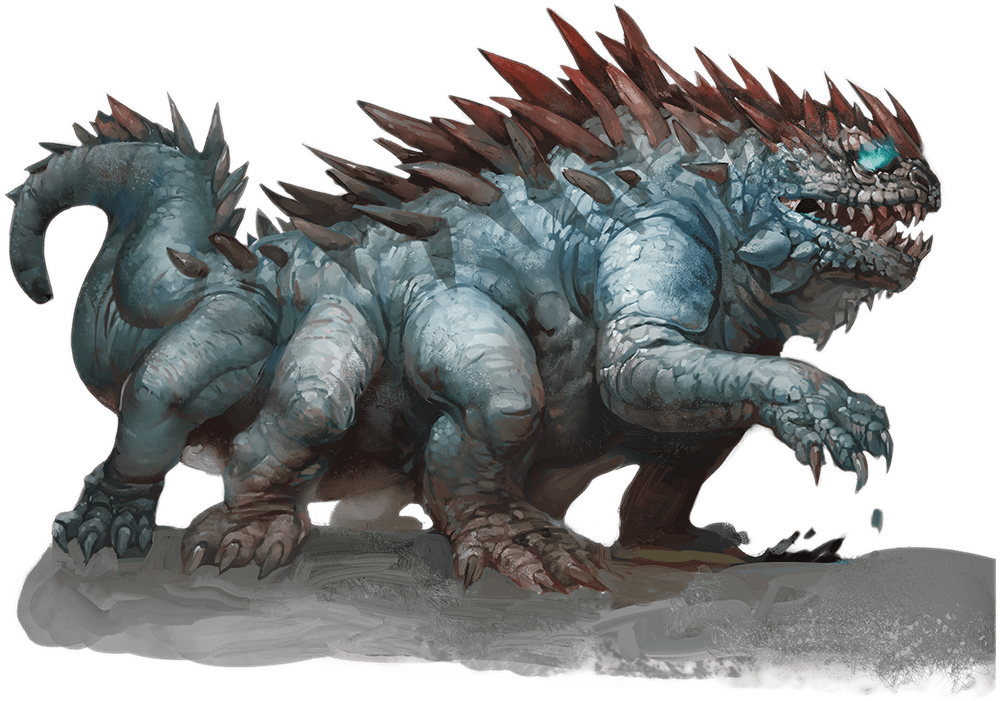Furore over dodgy AI-enhanced D&D art sees book revised and WotC swear off AI art for now (original) (raw)

(Image credit: Wizards of the Coast)
A preview for D&D's upcoming sourcebook, Bigby Presents: The Glory of Giants, was posted on the D&D beyond website last week—and the community is none too pleased. Fans spotted signs of AI generated artwork, with a tweet from NeverNotDM gathering over 7,000 likes after highlighting shoddy elements in the book's art.
Is Wizards using AI art in official sourcebooks? These images from Bigby's Presents are seriously concerning. At the best, it's terrible quality, at the worst, it means a lot of artists are going to lose jobs. #DnD #dnd5e pic.twitter.com/LIgBVUNzN4August 4, 2023
There are a lot of problems with artist Ilya Shkipin's work, here: one frost giant's legs simply devolved into wispy, confused brushes. Another giant's foot is twisted at an impossible angle, while their wolf companion sports painted human toenails in the place of fluffy paws.
Tabletop fans weren't exactly jazzed about the prospect of future books getting flooded with grubby AI work, plagued by uncanny anatomy and Schrodinger's feet. The comments on the inciting preview speak volumes, quickly devolving into debates over Shkipin's art.

(Image credit: D&D Beyond)
By Sunday, Wizards of the Coast aired an official statement on D&D Beyond's Twitter/X page, promising to not use AI for Wizards' artwork going forward.
On AI-generated art and Bigby Presents: Glory of the Giants: pic.twitter.com/q6oXRRITk9August 5, 2023
The tweet, which states the company has worked with artist Ilya Shkipin since 2014, claims that Wizards of the Coast were unaware the artist had used AI tools in the creation of his commissioned pieces. This is despite the fact that Shkipin has been publically pro-AI since 2021.
In a now-deleted statement—saved by NeverNotDM—Shkipin defended his use of the tools: "AI was used in the process to generate certain details or [in polishing] and editing … a lot of painted elements were enhanced with AI rather than generated from [the] ground up." The original sketches he shared, while definitely resembling the final thing, are free from the AI-generated errors of his final product.
This oversight continued to astound me when I saw some of his past work, as pointed out by D&D Beyond user Caerwyn_Glyndwr when they shared another piece Shkipin created from 2014's Monster Manual (according to Dungeons & Dragons official Pinterest account). The Basilisk he's rendered without these generative tools is perfectly fine. Great, even—it's a smashing monster with some real weight and texture to it. So why the shift to AI, if it just makes his artwork worse? That's a large hit to his reputation just to save some time.
Keep up to date with the most important stories and the best deals, as picked by the PC Gamer team.

(Image credit: Wizards of the Coast)
The blunder has also created a whirlwind of problems for anti-AI artists who've worked with Wizards of the Coast on the project, such as artist April Prime, who has produced concept art for the book that Shkipin used as the basis for certain pieces. As the rumour mill picked up speed, some fans were worried that the work of concept artists was simply being fed to AI by Shkipin wholesale.
One example even had to be debunked by both Shkipin and Prime in a knot of replies and accusations (the reality is, Shkipin made his own pieces based on her designs which were then "enhanced" with AI). I can't begin to imagine the headache involved in maintaining professional honesty in a situation like this, let alone the ethical discomfort.
According to Prime, it's normal for illustrators to use concept art from other artists as part of the process—her work was commissioned, so it's owned by Wizards of the Coast. What Shkipin did here wasn't illegal, though the use of generative AI programs is under constant debate, both in the courtroom and the court of public opinion.
It did, however, leave a sour taste in the mouth of tabletop fans and artists alike. The errors in the pieces are disappointing, but that's not what's driving so much anger in the community—it's the looming spectre of this new technology, which stands to vanish vital job opportunities for artists, especially in an industry that's already viciously competitive. To some artists, a seasoned professional like Shkipin using AI in their work feels like a betrayal, if not a complete fall from grace.
In this case, human-made art has won for now: Shkipin has revealed that the illustrations themselves are going to be reworked, though the specifics of that remain behind Wizards of the Coast's curtain.
Harvey's history with games started when he first begged his parents for a World of Warcraft subscription aged 12, though he's since been cursed with Final Fantasy 14-brain and a huge crush on G'raha Tia. He made his start as a freelancer, writing for websites like Techradar, The Escapist, Dicebreaker, The Gamer, Into the Spine—and of course, PC Gamer. He'll sink his teeth into anything that looks interesting, though he has a soft spot for RPGs, soulslikes, roguelikes, deckbuilders, MMOs, and weird indie titles. He also plays a shelf load of TTRPGs in his offline time. Don't ask him what his favourite system is, he has too many.